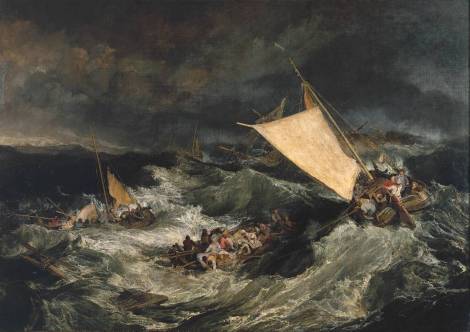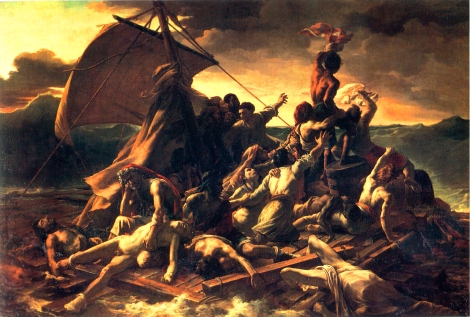The Strange Case of the Justified Cannibal: Some Thoughts on Representations of Cannibalism in Nineteenth Century Shipwreck Narratives
Introducing a new feature to the O.E., ‘Something I’m Not Working On’. One of the mixed blessings of academic study is the tangents it throws up which for one reason or another can’t be chased down. When you’re reading all day every day it’s difficult not to be sidetracked by ideas, images and arguments which fall outside the walls of your designated area of research. ‘Something I’m Not Working On’ will be a regular space for researchers to elaborate on those very outliers.
Sarah Sharp is a PhD candidate in English Literature at the University of Edinburgh. Sarah is not working on cannibalism at the moment although her work does focus on the status of the body during the nineteenth century. She is a current member of SWINC (Scottish Writing in the Nineteenth Century) and is a research assistant on the new Edinburgh edition of the collected works of Robert Louis Stevenson. Her doctoral thesis currently has the working title ‘Controlling the Corpse and Controlling the Corpus: Legislation and the Socialised Body in Nineteenth Century Scottish Literature’ and explores the relationship between law and the human body in nineteenth century Scottish writing, looking primarily at representations of irregular burial. Despite her research interests she bears no more than a passing and occasional resemblance to Morticia Adams.
Last year’s media frenzy around the ‘Miami Zombie’ and the Luka Rocco Magnotta murder case revealed the way that cannibalism continues to hold the power to both fascinate and horrify. International coverage of both cases was intense, with Magnotta even controversially named as ‘Canadian Newsmaker of the Year’ by the Canadian Press. The cases raised the question of how we understand and attempt to explain cannibalism in the context of a supposedly civilised world. Commentators quickly began to search for explanations which would justify these extreme and seemingly unexplainable events, citing the possible presence of new, extreme drugs or mental health issues. The acts seemed apocalyptic, inexplicable and savage. But media reactions to them also reminded me of some rather strange research I had completed for a Masters paper the following semester, looking at representations of cannibalism in popular nineteenth century shipwreck narratives. It was research which seemed to touch on many of the key themes which appeared in the media coverage I read over breakfast at the time: fears about social decline and modern morality. Although the crimes were quite different – the shipwrecked men of the eighteenth and nineteenth century acted in the face of starvation whereas the 2012 Cannibals’ motives were less easy to discern or sympathise with – in both instances cannibalism was used by commentators as a metaphor for pre-existing social problems. Whilst my knowledge of the 2012 zombies probably doesn’t qualify me to write an article on them, I hope this quick dusting off of some eighteenth and nineteenth century popular literature fills in a little of the context in which we conceptualise and discuss what is perhaps one of the last and greatest taboos in modern society.
Shipwreck narratives, of the type I looked at for this project, originate in the culture of Portuguese maritime imperialism during the sixteenth and seventeenth centuries. By the late eighteenth and early nineteenth centuries, written first-hand accounts of shipwrecks constituted a burgeoning sub-genre of the highly popular travel narrative which flourished in Britain, North America and Western Europe. The majority of shipwreck narratives were first published cheaply as pamphlets, before being compiled into collections, such as Dalyell’s Shipwrecks and Disasters at Sea. The popularity of the shipwreck narrative is not hard to understand, they are the equivalent of the mountaineer-eats-his-own-arm biographies which so often make modern bestseller lists. Historian Josiah Blackmore describes their manifold attractions for the eighteenth or nineteenth century reader:
Shipwreck narratives enticed and captivated readers with the dramatic, extraordinary and gory details of shipwreck and survival in faraway lands. They are prose litanies of deplorable hardships away from home, of the constant threat of piracy, treachery, starvation, mutiny and murder, of the inevitable presence of fear, death and disease in the violent struggle to remain alive (xx).
Additionally, the ubiquity of imperial and overseas enterprise within many Western cultures at the time gave these texts a personal appeal to many readers; they were reading uncanny versions of their own stories (Lincoln 172).
I looked at some of the most interesting stories from the 1812 edition of Dalyell’s collection (‘Famine Suffered on Board of the Peggy’ (1765), ‘Wreck of the Nautilus Sloop of War, on a Rock in the Archipelago’ (1807) and ‘Loss of the Nottingham Galley’ (1710)) and also examined the 1818 translation of Sevigny and Corréard’s account of the wreck of the Medusa. I was less interested in these accounts as historical documents than as literary objects. Shipwreck narratives are notorious for their extreme subjectivity, and accounts which include instances of cannibalism are understandably particularly contested. The shipwreck narrative’s problematic location within the liminal space between fiction and history is perhaps best illustrated by the controversy which continues to surround accounts of the wreck of the Nottingham Galley in 1710. The version included in the 1812 edition of Shipwrecks and Disasters at Sea is described as a collation from different sources and seems (based on narrative content) to have been largely taken from an account written by the captain of the ship, John Deane, most likely from his third (1727) revision of the text. However, this edition had been preceded by two other versions of the narrative written by Deane (each different on a number of key points) and by an alternative narrative written by his first-mate, boatswain and a seaman which they had produced in order to refute the earliest edition of Deane’s account (Erikson 378). The true nature of events onboard the Nottingham Galley and on Boon’s Island therefore remain a topic of heated historical speculation. A similar controversy surrounded versions of the wreck of the Medusa and prompted the publication of Savigny and Corréard’s account (Miles 3).
Further to this point, the introduction to Shipwrecks and Disasters at Sea itself admits that a policy of ‘partial modification’ has been practised on many of the stories the collection contains, and the stories themselves are almost uniformly taken from un-indicated sources (Dalyell 1:xiv). These narratives are not tied to an authorial identity and rigid structure as a novel or official report is, but have a status similar to that of oral tales in their facility for abridgement and communal appropriation. Blackmore cites ‘the existence of variants as evidence of the vitality of the genre’, arguing that the multiform nature of the shipwreck narrative suggests that these were stories which circulated and remained current within their culture through constant repetition and revision (xiv). My approach to the stories has therefore largely been as cultural objects: avoiding issues of authenticity and historical veracity I instead have been interested in the ways in which their presentations of cannibalism reveal intersections between race, class and the concept of civilisation.
The possibility of cannibalism is an ever-present spectre in a large number of historical accounts of shipwreck. There were multiple well-publicised incidences of what anthropologists refer to as ‘survival cannibalism’ in accounts of shipwrecks during the 18th and 19th century. Savigny and Corréard’s account of the wreck of the Medusa is perhaps the most notorious example of the period due to the iconic status of Théodore Gericault’s painting The Raft of the Medusa (1818-19). Savigny, a surgeon, and Corréard, a geographer, were travelling on board the French ship Medusa when she was wrecked off the coast of Senegal due to the gross mismanagement of the voyage by Bourbon officials. The ship contained insufficient lifeboats, so over 145 people were placed on a raft which was to be towed behind the lifeboats. However the ropes securing the raft were cut by those on the boats, and the raft with her living cargo was left to drift as the boats made for the coast. By the time they were picked up nearly two weeks later, only fifteen of those originally placed on the raft were still alive and it emerged that those who had survived had been driven to cannibalise the bodies of those who had been killed by a mutiny and the extreme conditions on board. Savigny and Corréard’s first hand account of events on board the raft caused sensation both in France and further afield and the book went on to be a bestseller.
The men’s description of the cannibal incidents which so fascinated and disturbed the contemporary public are largely motivated by a desire to explain and justify their decision to survive through the consumption of human flesh and to reveal the incompetence and malice of those who had left them to starve. Even prior to any mention of cannibalism, the authors emphasise the singularity of the situation in which they were placed : ‘he who has not been exposed to events, in which his existence was in imminent peril, can form but a faint idea of the value which one then sets upon the most common and simple objects’ (75). Following a narration of their failed attempts to acquire an alternative form of sustenance through fishing, Savigny and Corréard introduce the incident of cannibalism with an appeal to the reader’s moral judgement:
We tremble with horror at being obliged to mention that which we made use of! We feel our pen drop from our hand; a deathlike chill pervades all our limbs; our hair stands erect on our heads!-Reader, we beseech you, do not feel indignation towards men who are already too unfortunate; but have compassion on them, and shed some tears on their unhappy fate (107-108).
This desire for moral absolution appears to be a convention of the first-person shipwreck narratives in which cannibalism features, if we are to judge from the examples of cannibal narratives given in Shipwrecks and Disasters at Sea. In both the account of ‘The Wreck of the Nautilius Sloop’ and that of ‘Loss of the Nottingham Galley’ the narrators emphasise respectively their ‘prayers to Heaven for forgiveness of the sinful act’ and their ‘mature reflection and consultation on the lawfulness or sinfulness of the act’ (3:452, 2:16). The act of cannibalism entered into with repentance and reflection is therefore differentiated from spontaneous, frenzied consumption of human flesh. It is important in these accounts that the justified cannibal shows no signs of enjoyment when feeding on another man. He attempts to remain human, resisting attempts to cast him as animal.
This need to reaffirm the cannibal’s humanity ties into contemporary attitudes to the relationship between race and civilisation. In his analysis of nineteenth century attitudes to cannibalism Peter Kitson refers to the way in which ‘the figure of the ‘cannibal’ in the Romantic period and beyond becomes an instance of racial and moral degeneration’(4). Cannibals in the context of 18th and 19th century Imperialism are savage Others whose depravity is emphasised and differentiated from Western, Christian civilisation by the horrific act of consuming human flesh. The presentation of white “survival cannibalism” is inherently problematic, raising questions about the legitimacy of the categories of savagery and civilisation on which the entire imperial project is based. The tale of the Nautilus for example is introduced with the statement that ‘the expedition terminated in a way which did not enhance the repute of these islands in the eyes of the Turks’, emphasising the role of these stories in national myth making and breaking, and their potential to disturb contemporary racial hierarchies (441). The self-justifying cannibal in these British and French texts must therefore attempt a personal moral defence by placing his behaviour within a civilised process of rational and moral consideration; in examples such as the Medusa narrative the protagonists are attempting to reverse their own apparent degradation, and this motivation underlies their representation of their actions.
This differentiation between moral and immoral cannibalism is illustrated through contrasting the previously mentioned incidences of “moral” cannibalism with accounts such as the rather fascinating account of ‘Famine on the Peggy’, where cannibalism is described and observed by a third party. In the tale of the Peggy, the comparative immorality of the ship’s crew to their Captain is emphasised through the narrator’s presentation of their cannibalism. The men are made ‘desperate’ by their impending starvation and the narrator describes how they ‘seized the wine and brandy, and speedily rendering themselves intoxicated their exclamations of distress were mingled with curses and blasphemy’ (447). This loss of control is contrasted with Captain Harrison’s personal self-control and continence as he attempts to reason with his hunger-maddened crew and refuses to partake of human flesh despite his extreme hunger (although he does eat the head of the ship’s cat which ‘he devoured…with greater relish than he had ever enjoyed from tasting food’) (449).
Following these events an African slave is put to death by the crew after a questionable ballot and one sailor, James Campbell, is described as ‘so ravenously impatient, that, tearing the negro’s liver from the body, he devoured it raw’ (2:452). The men are then described as spending the ‘principle part of the night’ engaged in a cannibalistic feast (2:452). Some days later Campbell dies ‘raving mad’, an event which the text implies is a result of his animalistic consumption of the liver (452). It is obvious when comparing this account with the previously mentioned ones that the act is portrayed in a very different light. The sailors of the Peggy are rendered ‘savage’ in comparison to their more upper-class, pious captain through their uncivilised feasting and frenzy; their actions are represented as both bestial and ritualistic. Colonialism is turned upside down as the “savage” colonial subject is consumed by his rather more savage captors.
Similarly, in the version of the Nottingham Galley account included in Shipwrecks and Disasters at Sea, the not-always-entirely-faithful-to-the-truth Captain Deane attempts to exonerate himself of wrong doing through the depiction of his crew’s supposed depravity. Although he had himself also eaten the raw flesh of a dead crew-mate during the period on Boon Island, Deane identifies a moral degeneration in his crew’s behaviour following their consumption of human flesh; ‘in a few days, I found their natural dispositions quite changed…Nothing was heard but brutish quarrels, instead of that quiet submissive spirit of prayer and supplication which we had previously enjoyed’ (2:18). Even as first-hand accounts of survival cannibalism attempt to make their case for moral mitigation against the current of popular attitudes to the cannibal, third-party accounts utilise that same prevailing rhetoric of degeneration to allot moral superiority and inferiority within the shipwreck narrative, often basing this differentiation on social class.
Attempts to justify or impugn those involved in incidents of survival cannibalism were therefore inextricably tied into discourses of imperialism. The accounts of the justified cannibals of the eighteenth and nineteenth century reveal the ways in which distinctions between civilisation and savagery were utilised to impose social and racial hierarchies and the ways in which these hierarchies could be destabilised by extreme events which removed the cannibal from the hierarchies and relative safety of the ‘civilised’ world.
Works Cited
Blackmore, Josiah. Manifest Perdition: Shipwreck Narrative and the Disruption of Empire. Minneapolis: University of Minnesota Press. 2002.
Dalyell, Sir John. Ed. Shipwrecks and Disasters at Sea or Historical Narratives of the Most Noted and Providential Deliverances which have Resulted from Maritime Enterprise: With a Sketch of Various Expedients for Preserving the Lives of Mariners. 3 vols. Edinburgh: Archibald Constable and Co. 1812.
Erikson, Stephen. ‘”To Obviate a Scandalous Reflection”: Revisiting the Wreck of the Nottingham Galley’ from New England Quarterly. 83:3 (Sept 2010). 375-412.
Foulke, Robert. The Sea Voyage. New York and London: Routledge. 2002.
Kitson, Peter J. ‘”The Eucharist of Hell”; or, Eating People is Right: Romantic Representations of Cannibalism’ from Romanticism on the Net. 2000. 22 February 2012. <http://tinyurl.com/7l936gk>
Lincoln, Margarette. ‘Shipwreck Narratives of the Eighteenth and Early Nineteenth Century: Indicators of Culture and Identity’ from Journal of Eighteenth Century Studies. 20:2 (Sept 1997). 155-172.
Miles, Jonathan. Medusa: The Shipwreck, The Scandal, The Masterpiece. London: Jonathan Cape. 2007.
Obeyeseke, Gananath. ‘Cannibal Feasts in Nineteenth Century Fiji: Seamen’s Yarns and the Ethnographic Imagination’ from Cannibalism and the Colonial World. Ed Francis Barker, Peter Hulme and Margaret Iversen. Cambridge: Cambridge University Press. 1998.
Roleau, Brian J. ‘Dead Men Do Tell Tales: Folklore, Fraternity and the Forecastle’ from Early American Studies. 5:1 (Spring 2007). 30-62.
Savigny, Henry and Alexander Corréard. Narrative of a Voyage to Senegal in 1816. London: Dawsons of Pall Mall. 1968.
Snader, Joe. Caught Between Worlds: British Captivity Narratives in Fact and Fiction. Lexington, KY: University of Kentucky Press. 2000.


